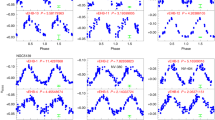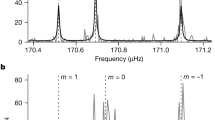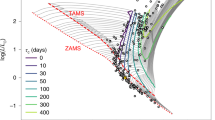Abstract
M dwarfs are the most numerous stars in our Galaxy, with masses between approximately 0.5 and 0.1 solar masses. Many of them show surface activity qualitatively similar to our Sun and generate flares, high X-ray fluxes and large-scale magnetic fields1,2,3,4. Such activity is driven by a dynamo powered by the convective motions in their interiors2,5,6,7,8. Understanding properties of stellar magnetic fields in these stars finds a broad application in astrophysics, including theory of stellar dynamos and environment conditions around planets that may be orbiting these stars. Most stars with convective envelopes follow a rotation–activity relationship where various activity indicators saturate in stars with rotation periods shorter than a few days2,6,8. The activity gradually declines with rotation rate in stars rotating more slowly. It is thought that, due to a tight empirical correlation between X-ray radiance and magnetic flux9, the stellar magnetic fields will also saturate, to values around 4 kG (ref. 10). Here we report the detection of magnetic fields above the presumed saturation limit in four fully convective M dwarfs. By combining results from spectroscopic and polarimetric studies, we explain our findings in terms of bistable dynamo models11,12: stars with the strongest magnetic fields are those in a dipole dynamo state, whereas stars in a multipole state cannot generate fields stronger than about 4 kG. Our study provides observational evidence that the dynamo in fully convective M dwarfs generates magnetic fields that can differ not only in the geometry of their large-scale component, but also in the total magnetic energy.
This is a preview of subscription content, access via your institution
Access options
Access Nature and 54 other Nature Portfolio journals
Get Nature+, our best-value online-access subscription
$29.99 / 30 days
cancel any time
Subscribe to this journal
Receive 12 digital issues and online access to articles
$119.00 per year
only $9.92 per issue
Buy this article
- Purchase on Springer Link
- Instant access to full article PDF
Prices may be subject to local taxes which are calculated during checkout


Similar content being viewed by others
References
Baliunas, S. L. et al. Chromospheric variations in main-sequence stars. Astrophys. J. 438, 269–287 (1995).
Noyes, R. W., Hartmann, L. W., Baliunas, S. L., Duncan, D. K. & Vaughan, A. H. Rotation, convection, and magnetic activity in lower main-sequence stars. Astrophys. J. 279, 763–777 (1984).
Charbonneau, P. S. & Dynamos,, S . Solar and Stellar Dynamos: Saas-Fee Advanced Course 39 Swiss Society for Astrophysics and Astronomy, Saas-Fee Advanced Courses Vol. 39. (Springer-Verlag, 2013).
Reiners, A. Observations of cool-star magnetic fields. Living Rev. Sol. Phys. 9, 1 (2012).
Pallavicini, R. et al. Relations among stellar X-ray emission observed from Einstein, stellar rotation and bolometric luminosity. Astrophys. J. 248, 279–290 (1981).
Pizzolato, N., Maggio, A., Micela, G., Sciortino, S. & Ventura, P. The stellar activity–rotation relationship revisited: dependence of saturated and non-saturated X-ray emission regimes on stellar mass for late-type dwarfs. Astron. Astrophys. 397, 147–157 (2003).
Wright, N. J., Drake, J. J., Mamajek, E. E. & Henry, G. W. The stellar-activity–rotation relationship and the evolution of stellar dynamos. Astrophys. J. 743, 48 (2011).
Reiners, A., Schüssler, M. & Passegger, V. M. Generalized investigation of the rotation–activity relation: favoring rotation period instead of Rossby number. Astrophys. J. 794, 144 (2014).
Pevtsov, A. A. et al. The relationship between X-ray radiance and magnetic flux. Astrophys. J. 598, 1387–1391 (2003).
Reiners, A., Basri, G. & Browning, M. Evidence for magnetic flux saturation in rapidly rotating M stars. Astrophys. J. 692, 538–545 (2009).
Gastine, T. et al. What controls the magnetic geometry of M dwarfs? Astron. Astrophys. 549, L5 (2013).
Garraffo, C., Drake, J. J. & Cohen, O. Magnetic complexity as an explanation for bimodal rotation populations among young stars. Astrophys. J. 807, L6 (2015).
Morin, J. et al. Large-scale magnetic topologies of late M dwarfs. Mon. Not. R. Astron. Soc. 407, 2269–2286 (2010).
Kiraga, M. & Stepien, K. Age–rotation–activity relations for M dwarf stars. Acta Astronom. 57, 149–172 (2007).
Newton, E. R. et al. The Hα emission of nearby M dwarfs and its relation to stellar rotation. Astrophys. J. 834, 85 (2017).
Saar, S. H. & Linsky, J. L. The photospheric magnetic field of the dM3.5e flare star AD Leonis. Astrophys. J. 299, L47–L50 (1985).
Johns-Krull, C. M. & Valenti, J. A. Detection of strong magnetic fields on M dwarfs. Astrophys. J. 459, L95 (1996).
Reiners, A. & Basri, G. The first direct measurements of surface magnetic fields on very low mass stars. Astrophys. J. 656, 1121–1135 (2007).
Reiners, A. & Basri, G. A volume-limited sample of 63 M7–M9.5 dwarfs. II. Activity, magnetism, and the fade of the rotation-dominated dynamo. Astrophys. J. 710, 924–935 (2010).
Christensen, U. R., Holzwarth, V. & Reiners, A. Energy flux determines magnetic field strength of planets and stars. Nature 457, 167–169 (2009).
Morin, J., Hill, C. A. & Watson, C. A. in Astronomy at High Angular Resolution Vol. 439 (eds Boffin, H. M. J. et al.) 223 (Astrophysics and Space Science Library, Springer, 2016).
Reiners, A. & Basri, G. On the magnetic topology of partially and fully convective stars. Astron. Astrophys. 496, 787–790 (2009).
Petit, P. et al. PolarBase: a database of high-resolution spectropolarimetric stellar observations. Publ. Astron. Soc. Pac. 126, 469–475 (2014).
Kochukhov, O. & Lavail, A. The global and small-scale magnetic fields of fully convective, rapidly spinning M dwarf pair GJ65 A and B. Astrophys. J. 835, L4 (2017).
Kochukhov, O. et al. Magnetic fields in M dwarf stars from high-resolution infrared spectra. In 15th Cambridge Workshop on Cool Stars, Stellar Systems, and the Sun Vol. 1094 (ed. Stempels, E.) 124–129 (American Institute of Physics Conference Proc., 2009).
Yadav, R. K. et al. Explaining the coexistence of large-scale and small-scale magnetic fields in fully convective stars. Astrophys. J. 813, L31 (2015).
Robertson, P., Endl, M., Cochran, W. D. & Dodson-Robinson, S. E. Hα activity of old M dwarfs: stellar cycles and mean activity levels for 93 low-mass stars in the solar neighborhood. Astrophys. J. 764, 3 (2013).
Wargelin, B. J., Saar, S. H., Pojmański, G., Drake, J. J. & Kashyap, V. L. Optical, UV, and X-ray evidence for a 7-yr stellar cycle in Proxima Centauri. Mon. Not. R. Astron. Soc. 464, 3281–3296 (2017).
Yadav, R. K., Christensen, U. R., Wolk, S. J. & Poppenhaeger, K. Magnetic cycles in a dynamo simulation of fully convective M-star Proxima Centauri. Astrophys. J. 833, L28 (2016).
Shulyak, D., Sokoloff, D., Kitchatinov, L. & Moss, D. Towards understanding dynamo action in M dwarfs. Mon. Not. R. Astron. Soc. 449, 3471–3478 (2015).
Shulyak, D., Tsymbal, V., Ryabchikova, T., Stütz, C. & Weiss, W. W. Line-by-line opacity stellar model atmospheres. Astron. Astrophys. 428, 993–1000 (2004).
Khan, S. A. & Shulyak, D. V. Stellar model atmospheres with magnetic line blanketing. II. Introduction of polarized radiative transfer. Astron. Astrophys. 448, 1153–1164 (2006).
Rees, D. E., Durrant, C. J. & Murphy, G. A. Stokes profile analysis and vector magnetic fields. II. Formal numerical solutions of the Stokes transfer equations. Astrophys. J. 339, 1093–1106 (1989).
Piskunov, N. & Kochukhov, O. Doppler imaging of stellar magnetic fields. I. Techniques. Astron. Astrophys. 381, 736–756 (2002).
Kurucz, R. L. ATLAS12, SYNTHE, ATLAS9, WIDTH9, et cetera. Memorie della Societa Astronomica Italiana Supplementi 8, 14 (2005).
Irwin, A. W. Polynomial partition function approximations of 344 atomic and molecular species. Astrophys. J. Suppl. Ser. 45, 621–633 (1981).
Irwin, A. W. Refined diatomic partition functions. I. Calculational methods and H2 and CO results. Astron. Astrophys. 182, 348–358 (1987).
Sauval, A. J. & Tatum, J. B. A set of partition functions and equilibrium constants for 300 diatomic molecules of astrophysical interest. Astrophys. J. Suppl. Ser. 56, 193–209 (1984).
Irwin, A. W. The partition functions of JANAF polyatomic molecules that significantly affect the stellar atmospheric equation of state. Astron. Astrophys. Suppl. Ser. 74, 145–160 (1988).
Irwin, A. W. An Observational and Theoretical Study of MK Classification Criteria from g5 to K5. PhD thesis, Univ. Toronto (1978).
Kochukhov, O. P. in Physics of Magnetic Stars (eds Romanyuk, I. I. et al.) 109–118 (Proc. International Conference Special Astrophysical Observatory of the Russian Academy of Sciences, 2007).
Pavlenko, Y. V., Zhukovska, S. V. & Volobuev, M. Resonance potassium and sodium lines in the spectra of ultracool dwarfs. Astron. Rep. 51, 282–290 (2007).
Wende, S., Reiners, A. & Ludwig, H.-G. 3D simulations of M star atmosphere velocities and their influence on molecular FeH lines. Astron. Astrophys. 508, 1429–1442 (2009).
Shulyak, D., Reiners, A., Seemann, U., Kochukhov, O. & Piskunov, N. Exploring the magnetic field complexity in M dwarfs at the boundary to full convection. Astron. Astrophys. 563, A35 (2014).
Gustafsson, B. et al. A grid of MARCS model atmospheres for late-type stars. I. Methods and general properties. Astron. Astrophys. 486, 951–970 (2008).
Kenyon, S. J. & Hartmann, L. Pre-main-sequence evolution in the Taurus-Auriga molecular cloud. Astrophys. J. Suppl. Ser. 101, 117 (1995).
Golimowski, D. A. et al. Lʹ and Mʹ photometry of ultracool dwarfs. Astron. J. 127, 3516–3536 (2004).
Piskunov, N. E., Kupka, F., Ryabchikova, T. A., Weiss, W. W. & Jeffery, C. S. VALD: the Vienna Atomic Line Data Base. Astron. Astrophys. Suppl. Ser. 112, 525 (1995).
Kupka, F., Piskunov, N., Ryabchikova, T. A., Stempels, H. C. & Weiss, W. W. VALD-2: progress of the Vienna Atomic Line Data Base. Astron. Astrophys. Suppl. Ser. 138, 119–133 (1999).
Davis, S. P., Phillips, J. G. & Littleton, J. E. Transition rates for the TiO beta, delta, phi, gamma-prime, gamma, and alpha systems. Astrophys. J. 309, 449–454 (1986).
Ram, R. S., Bernath, P. F., Dulick, M. & Wallace, L. The A3Φ–X3Δ system (γ bands) of TiO: laboratory and sunspot measurements. Astrophys. J. Suppl. Ser. 122, 331–353 (1999).
Nordlander, T. Analyses of Cool Stars using Molecular Lines. Master’s thesis, Uppsala Univ. (2012); http://urn.kb.se/resolve?urn=urn:nbn:se:uu:diva-174640
Mann, A. W., Feiden, G. A., Gaidos, E., Boyajian, T. & von Braun, K. How to constrain your M dwarf: measuring effective temperature, bolometric luminosity, mass, and radius. Astrophys. J. 804, 64 (2015).
Dotter, A. et al. The Dartmouth Stellar Evolution Database. Astrophys. J. Suppl. Ser. 178, 89–101 (2008).
Bressan, A. et al. PARSEC: stellar tracks and isochrones with the PAdova and TRieste Stellar Evolution Code. Mon. Not. R. Astron. Soc. 427, 127–145 (2012).
Valenti, J. A., Johns-Krull, C. M. & Piskunov, N. E. Using FeH to measure magnetic fields on cool stars and brown dwarfs (CD-ROM directory: contribs/valenti). In 11th Cambridge Workshop on Cool Stars, Stellar Systems and the Sun Vol. 223 (eds Garcia Lopez, R. J. et al.) 1579 (Astronomical Society of the Pacific Conference Proc., 2001).
Reiners, A. & Basri, G. Measuring magnetic fields in ultracool stars and brown dwarfs. Astrophys. J. 644, 497–509 (2006).
Shulyak, D., Seifahrt, A., Reiners, A., Kochukhov, O. & Piskunov, N. Rotation, magnetism and metallicity of M dwarf systems. Mon. Not. R. Astron. Soc. 418, 2548–2557 (2011).
Shulyak, D. et al. Modelling the molecular Zeeman-effect in M-dwarfs: methods and first results. Astron. Astrophys. 523, A37 (2010).
Asensio Ramos, A. & Trujillo Bueno, J. Theory and modeling of the Zeeman and Paschen–Back effects in molecular lines. Astrophys. J. 636, 548–563 (2006).
Berdyugina, S. V. & Solanki, S. K. The molecular Zeeman effect and diagnostics of solar and stellar magnetic fields. I. Theoretical spectral patterns in the Zeeman regime. Astron. Astrophys. 385, 701–715 (2002).
Afram, N., Berdyugina, S. V., Fluri, D. M., Solanki, S. K. & Lagg, A. The FeH F4Δ–X4Δ system. Creating a valuable diagnostic tool to explore solar and stellar magnetic fields. Astron. Astrophys. 482, 387–395 (2008).
Kurucz, R. L., Furenlid, I., Brault, J. & Testerman, L. Book-Review—Solar Flux Atlas from 296 to 1300 nm. Sky Telescope 70, 38 (1985).
Landi Degl’Innocenti, E. & Landolfi, M. (eds) Polarization in Spectral Lines Vol. 307 (Astrophysics and Space Science Library, Kluwer Academic, 2004).
Smette, A. et al. MOLECFIT: A general tool for telluric absorption correction. I. Method and application to ESO instruments. Astron. Astrophys. 576, A77 (2015).
Kausch, W. et al. MOLECFIT: A general tool for telluric absorption correction. II. Quantitative evaluation on ESO-VLT/X-Shooterspectra. Astron. Astrophys. 576, A78 (2015).
Saar, S. H. in Stellar Surface Structure Vol. 176 (eds Strassmeier, K. G. & Linsky, J. L. ) 237 (Proc. 176th Symposium of the International Astronomical Union, Kluwer Academic, 1996).
Johns-Krull, C. M. & Valenti, J. A. in Stellar Clusters and Associations: Convection, Rotation, and Dynamos Vol. 198 (eds Pallavicini, R. et al.) 371 (Astronomical Society of the Pacific Conference Proc., 2000).
Acknowledgements
This project was carried out in the framework of the Deutsche Forschungsgemeinschaft funded CRC 963—Astrophysical Flow Instabilities and Turbulence (projects A16 and A17). We acknowledge support from the Deutscher Akademischer Austauschdienst strategic partnership project U4-Network to D.S. and funding through a Heisenberg Professorship, RE 1664/9-2, to A.R. R.Y. is supported by NASA Chandra grant GO4-15011X. O.K. acknowledges funding from the Swedish Research Council and the Swedish National Space Board. We also acknowledge the use of electronic databases (VALD, SIMBAD, NASA Astrophysics Data System). This research is based on observations collected at the Canada–France–Hawaii Telescope (Hawaii) and Télescope Bernard Lyot (France).
Author information
Authors and Affiliations
Contributions
D.S. contributed general scientific ideas and conclusions, carried out the processing, modelling and analysis of observed data. A.R. contributed general scientific ideas and conclusions. A.E. carried out modelling and analysis of observed data. L.M. carried out telluric correction on selected targets. R.Y. provided theoretical dynamo models and magnetic maps. J.M. provided and analysed additional Stokes V data on some ESPaDOnS targets. O.K. contributed to development of atomic line analysis methodology. All authors contributed to the text of the paper and discussed the results.
Corresponding author
Ethics declarations
Competing interests
The authors declare no competing financial interests.
Supplementary information
Supplementary Information
Supplementary Tables 1–2, Supplementary Figures 1–22 and Supplementary References. (PDF 2288 kb)
Rights and permissions
About this article
Cite this article
Shulyak, D., Reiners, A., Engeln, A. et al. Strong dipole magnetic fields in fast rotating fully convective stars. Nat Astron 1, 0184 (2017). https://doi.org/10.1038/s41550-017-0184
Received:
Accepted:
Published:
DOI: https://doi.org/10.1038/s41550-017-0184
This article is cited by
-
Ultraviolet spectropolarimetric diagnostics of hot star magnetospheres
Astrophysics and Space Science (2022)
-
Magnetic fields of M dwarfs
The Astronomy and Astrophysics Review (2021)
-
Coherent radio emission from a quiescent red dwarf indicative of star–planet interaction
Nature Astronomy (2020)



